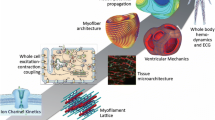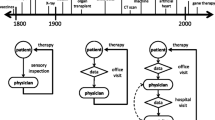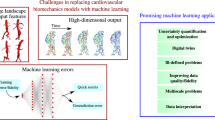Abstract
Over the last few decades, technological developments have made diagnostic information of the cardiovascular system far more detailed. These improvements are prominently attributed to the general availability of many imaging techniques, such as ultrasonic echo imaging, computer tomography (CT), Magnetic Resonance Imaging (MRI), and Positron Emission Tomography (PET). After primary diagnosis, treatment starts by following a protocol that is considered best, given the available information. Following the standard route, such protocol is a result of empirical clinical studies, where effects of different treatments are compared statistically in large groups of patients with similar pathology. With increase of diagnostic detail, groups become less uniform, forcing us to make the subgroups smaller and more numerous. Due to the technological improvements, the choice and possible graduation of therapeutic interventions increase too. As a result, with the conventional epidemiological setup of such studies, it will ever be more difficult to reach the level of significance for obtaining better treatment protocols.
Access this chapter
Tax calculation will be finalised at checkout
Purchases are for personal use only
Similar content being viewed by others
References
Arts, T., P. H. M. Bovendeerd, et al. (1991). “Relation between left ventricular cavity pressure and volume and systolic fiber stress and strain in the wall.” Biophys J 59: 93–103.
Arts, T., K. D. Costa, et al. (2001). “Relating myocardial laminar architecture to shear strain and muscle fiber orientation.” Am J Physiol 280: H2222–H2229.
Arts, T., T. Delhaas, et al. (2005). “Adaptation to mechanical load determines shape and properties of heart and circulation, the CircAdapt model.” Am J Physiol Heart Circ Physiol 288: 1943–1954.
Arts, T., F. W. Prinzen, et al. (1994). “Adaptation of cardiac structure by mechanical feedback in the environment of the cell, a model study.” Biophys J 66: 953–961.
Axel, L. and L. Dougherty (1989). “MR imaging of motion with spatial modulation of magnetization.” Radiology 171: 841–845.
Bovendeerd, P. H. M., T. Arts, et al. (1992). “Dependence of left ventricular wall mechanics on myocardial fiber orientation: a model study.” J Biomech 25: 1129–1140.
Brownlee, R. D. and B. L. Langille (1991). “Arterial adaptations to altered blood flow.” Can J Physiol Pharmacol 69(7): 978–983.
Chadwick, R. S. (1982). “Mechanics of the left ventricle.” Biophys J 39: 279–288.
Costa, K. D., Y. Takayama, et al. (1999). “Laminar fiber architecture and three-dimensional systolic mechanics in canine ventricular myocardium.” Am J Physiol 276(2 Pt 2): H595–H607.
Cupps, B. P., P. Moustakidis, et al. (2003). “Severe aortic insufficiency and normal systolic function: determining regional left ventricular wall stress by finite-element analysis.” Ann Thorac Surg 76(3): 668–675; discussion 675.
Dawson, T. H. (2001). “Similitude in the cardiovascular system of mammals.” J Exp Biol 204(Pt 3): 395–407.
Devereux, R. B. and M. J. Roman (1999). “Left ventricular hypertrophy in hypertension: stimuli, patterns, and consequences.” Hypertens Res 22(1): 1–9.
Donker, D. W., J. G. Maessen, et al. (2007). “Impact of acute and enduring volume overload on mechanotransduction and cytoskeletal integrity of canine left ventricular myocardium.” Am J Physiol Heart Circ Physiol 292(5): H2324–H2332.
Emery, J. L., J. H. Omens, et al. (1997). “Strain softening in rat left ventricular myocardium.” J Biomech Eng 119(1): 6–12.
Guccione, J. M., K. D. Costa, et al. (1995). “Finite element stress analysis of left ventricular mechanics in the beating dog heart.” J Biomech 28: 1167–1177.
Guccione, J. M., W. G. O’Dell, et al. (1997). “Anterior and posterior left ventricular sarcomere lengths behave similarly during ejection.” Am J Physiol 272: H449–H477.
Guyton, A. C., J. P. Montani, et al. (1988). “Computer models for designing hypertension experiments and studying concepts.” Am J Med Sci 295(4): 320–326.
Hann, C. E., J. G. Chase, et al. (2006). “Integral-based identification of patient specific parameters for a minimal cardiac model.” Comput Methods Programs Biomed 81(2): 181–192.
Holmes, J. W. (2004). “Candidate mechanical stimuli for hypertrophy during volume overload.” J Appl Physiol 97(4): 1453–1460.
Kerckhoffs, R. C., A. D. McCulloch, et al. (2008). “Effects of biventricular pacing and scar size in a computational model of the failing heart with left bundle branch block.” Med Image Anal 13, 362–369.
Kerckhoffs, R. C., M. L. Neal, et al. (2007). “Coupling of a 3D finite element model of cardiac ventricular mechanics to lumped systems models of the systemic and pulmonic circulation.” Ann Biomed Eng 35(1): 1–18.
Kerckhoffs, R. C. P., Omens, J. H., McCulloch, A. D. and Mulligan, L. J. (2010) Ventricular dilation and electrical dyssynchrony synergistically increase regional mechanical nonuniformity but not mechanical dyssynchrony: A computational model.” Circulation: Heart Failure 3, 528–536.
Kim, H. J., I. E. Vignon-Clementel, et al. (2009). “On coupling a lumped parameter heart model and a three-dimensional finite element aorta model.” Ann Biomed Eng 37(11): 2153–2169.
Kroon, W., T. Delhaas, et al. (2009). “Computational analysis of the myocardial structure: adaptation of cardiac myofiber orientations through deformation.” Med Image Anal 13(2): 346–353.
Kuijpers, N. H., H. M. Ten Eikelder, et al. (2008). “Mechanoelectric feedback as a trigger mechanism for cardiac electrical remodeling: a model study.” Ann Biomed Eng 36(11): 1816–1835.
LeGrice, I. J., B. H. Smaill, et al. (1995). “Laminar structure of the heart: ventricular myocyte arrangement and connective tissue architecture in the dog.” Am J Physiol 269: H571–H582.
Lumens, J., T. Delhaas, et al. (2006). “Impaired subendocardial contractile myofiber function in asymptomatic aged humans, as detected using MRI.” Am J Physiol Heart Circ Physiol 291(4): H1573–H1579.
Lumens, J., T. Delhaas, et al. (2008). “Modeling ventricular interaction: a multiscale approach from sarcomere mechanics to cardiovascular system hemodynamics.” Pac Symp Biocomput 13: 378–389.
Lumens, J., T. Delhaas, et al. (2009). “Three-wall segment (TriSeg) model describing mechanics and hemodynamics of ventricular interaction.” Ann Biomed Eng 37(11): 2234–2255.
Luo, C. H. and Y. Rudy (1994). “A dynamic model of the cardiac ventricular action potential. II. After depolarizations, triggered activity, and potentiation.” Circ Res 74(6): 1097–1113.
Milhorn, H. T., Jr., R. Benton, et al. (1965). “A mathematical model of the human respiratory control system.” Biophys J 5: 27–46.
Nguyen, T. N., A. C. Chagas, et al. (1993). “Left ventricular adaptation to gradual renovascular hypertension in dogs.” Am J Physiol 265(1 Pt 2): H22–H38.
Olansen, J. B., J. W. Clark, et al. (2000). “A closed-loop model of the canine cardiovascular system that includes ventricular interaction.” Comput Biomed Res 33(4): 260–295.
Olivetti, G., J. M. Capasso, et al. (1990). “Side-to-side slippage of myocytes participates in ventricular wall remodeling acutely after myocardial infarction in rats.” Circ Res 67(1): 23–34.
Omens, J. H. (1998). “Stress and strain as regulators of myocardial growth.” Prog Biophys Mol Biol 69(2–3): 559–572.
Opie, L. H., P. J. Commerford, et al. (2006). “Controversies in ventricular remodelling.” Lancet 367(9507): 356–367.
Pennati, G., F. Migliavacca, et al. (1997). “A mathematical model of circulation in the presence of the bidirectional cavopulmonary anastomosis in children with a univentricular heart.” Med Eng Phys 19(3): 223–234.
Rice, J. J., F. Wang, et al. (2008). “Approximate model of cooperative activation and crossbridge cycling in cardiac muscle using ordinary differential equations.” Biophys J 95(5): 2368–2390.
Rudy, Y. and J. R. Silva (2006). “Computational biology in the study of cardiac ion channels and cell electrophysiology.” Q Rev Biophys 39(1): 57–116.
Sasayama, S., J. Ross, et al. (1976). “Adaptations of the left ventricle to chronic pressure overload.” Circ Res 38: 172–178.
Sermesant, M., P. Moireau, et al. (2006). “Cardiac function estimation from MRI using a heart model and data assimilation: advances and difficulties.” Med Image Anal 10(4): 642–656.
Streeter, D. D. (1979). Gross morphology and fiber geometry of the heart. In R. M. Berne, editor. The cardiovascular system, the heart, vol. 1. Bethesda, Maryland, USA, Am Physiol Soc: 61–112.
Sun, Y., M. Beshara, et al. (1997). “A comprehensive model for right-left heart interaction under the influence of pericardium and baroreflex.” Am J Physiol 272(3 Pt 2): H1499–H1515.
Ten Tusscher, K. H., O. Bernus, et al. (2006). “Comparison of electrophysiological models for human ventricular cells and tissues.” Prog Biophys Mol Biol 90(1–3): 326–345.
Ten Tusscher, K. H. and A. V. Panfilov (2006). “Cell model for efficient simulation of wave propagation in human ventricular tissue under normal and pathological conditions.” Phys Med Biol 51(23): 6141–6156.
Thomas, J. D., J. Zhou, et al. (1997). “Physical and physiological determinants of pulmonary venous flow: numerical analysis.” Am J Physiol 272(5 Pt 2): H2453–H2465.
Tseng, W. Y., T. G. Reese, et al. (1999). “Cardiac diffusion tensor MRI in vivo without strain correction.” Magn Reson Med 42(2): 393–403.
Van der Toorn, A., P. Barenbrug, et al. (2002). “Transmural gradients of cardiac myofiber shortening in aortic valve stenosis patients using MRI-tagging.” Am J Physiol 283: H1609–H1615.
Van Steenhoven, A. A. and M. E. H. Van Dongen (1979). “Model studies of the closing behavior of the aortic valve.” J Fluid Mech 90: 21–32.
Wang, V. Y., H. I. Lam, et al. (2009). “Modelling passive diastolic mechanics with quantitative MRI of cardiac structure and function.” Med Image Anal 13(5): 773–784.
Womersley, J. R. (1957). “Oscillatory flow in arteries: the constrained elastic tube as a model of arterial flow and pulse transmission.” Phys Med Biol 2(2): 178–187.
Author information
Authors and Affiliations
Corresponding author
Editor information
Editors and Affiliations
Rights and permissions
Copyright information
© 2010 Springer Science+Business Media, LLC
About this chapter
Cite this chapter
Arts, T., Lumens, J., Kroon, W., Donker, D., Prinzen, F., Delhaas, T. (2010). Patient-Specific Modeling of Cardiovascular Dynamics with a Major Role for Adaptation. In: Kerckhoffs, R. (eds) Patient-Specific Modeling of the Cardiovascular System. Springer, New York, NY. https://doi.org/10.1007/978-1-4419-6691-9_2
Download citation
DOI: https://doi.org/10.1007/978-1-4419-6691-9_2
Published:
Publisher Name: Springer, New York, NY
Print ISBN: 978-1-4419-6690-2
Online ISBN: 978-1-4419-6691-9
eBook Packages: Biomedical and Life SciencesBiomedical and Life Sciences (R0)




